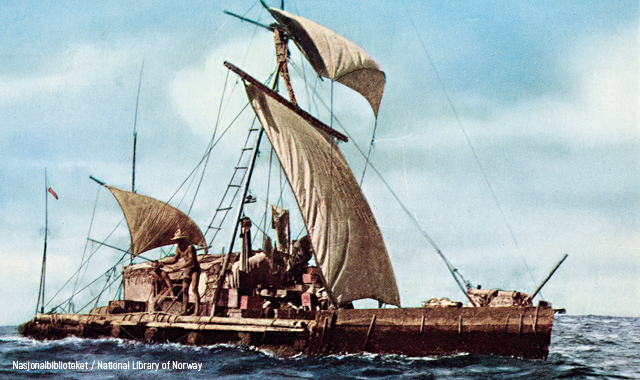On August 7, 1947, Thor Heyerdahl completed his arduous journey–a nearly 4,300 nautical mile trip across the Pacific Ocean. The balsa wood raft, the Kon-Tiki, propelled Heyerdahl into the upper echelon of famous Norwegian explorers and rewrote how we understood human migration and early exploration. Heyerdahl catalogued his experiences in the popular memoir “The Kon-Tiki Expedition: By Raft Across the South Seas” which was released in 1948. “Kon-Tiki,” the movie, was released in 1950 and won an Oscar for best documentary.
Want to learn more about Thor Heyerdahl and his amazing journey? Here are five facts about the man behind the expedition.
Resourcefulness
The U.S. military donated materials to the crew, including tins of food to eat. However, the crew reported that fish were plentiful and they often used what they could catch from the ocean, including flying fish, tuna and even shark.
Resistance Connection
Although Kon-Tiki was constructed using technologies used by pre-Columbian people, there were some technological features on the raft, including a radio. In fact, the radio was operated by two members of the Norwegian resistance, Knut Haugland and Torstein Raaby, who were in communication with people throughout North and South America, including the Norwegian embassy in Washington, D.C.
Solid Planning
Heyerdahl had estimated it would take approximately 97 days to reach his intended destination, the Tuamotu Archipelago from Peru. He was close – the westward voyage took 101 days, sailing at an average speed of 1.7 nautical miles an hour.
Continued Quests
Successfully sailing across the Pacific Ocean didn’t damper Heyerdahl’s excitement for adventure. After the Kon-Tiki expedition he would dedicate his remaining years to exploration, including archaeological trips to Easter Island and attempted voyages across the Atlantic in Egyptian reed ships. In fact, one of Heyerdahl’s Egyptian reed ships, the “Ra II,” is on exhibit at the Kon-Tiki museum in Oslo.
Lasting Legacy
Today, most modern historians discount much of Heyerdahl’s theory that pre-Columbian civilizations could have colonized Polynesia. DNA evidence points toward settlement from the east. However, Heyerdahl’s expedition definitively proved that pre-Columbians were capable of making the voyage west.
Looking for more about famous Norwegians? You’ll love:


